From May 16th to May 31st, 2014 Beth and I were in Peru.
We visited Lima where Beth ran a half marathon, Cusco, hiked the 4 day Inca trail to Machu Picchu, Aguas Calientes, took a 10 hour train from Cusco to Puno, and visited the floating islands and Taquile island at Titicaca Lake.
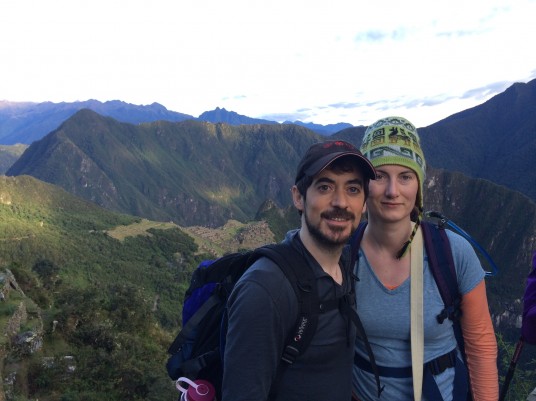
To keep track of the highlights of the trip I used the default notes app on my iPhone.
I write keywords as I go with the hope that later on they will help trigger memories since my memory is terrible.
This post is going to be an experiment to share all the highlights and impressions in the most concise and efficient manner. Like a Grumo video but in written form 🙂 . [Update: Ok, after reading my notes many memories were triggered and the article turned out to be longer and juicer than expected]
To make navigation simpler I created this index so you can skip to whichever part of the trip floats your boat:
- Lima – Pollution, crazy traffic
- Cusco – touristy, pretty
- Inca Trail to Machu Picchu – Awesome
- Day 1 – Easy
- Day 2 – Worst day ever!
- Day 3 – Best day ever!
- The Awkward Tipping Ceremony – Rant (you can skip)
- Awkward speech – Amusing
- Tipping Conundrum – Rant (you can skip)
- The Porters: – Tiny super heroes
- Day 4 – Machu Picchu: The perfect day
- Aguas Calientes: Goodbyes and good times
- Back to Cusco – Our luggage is intact
- Luxury Train to Puno – 10 hours with new friends
- Floating Islands and Taquile – Titicaca Lake – all peace and beauty
- Back to Lima – Miraflores is prettier
- American Airlines BS – AA vs Peru (Rant)
- After Thoughts – Sharing feelings about the trip
- Trip trivia
Lima
We arrived late at night on a Friday. As expected from watching a YouTube video as soon as we exited into the arrivals zone there were dozens of taxi drivers calling “taxi? taxi? taxi?”.
We had arranged a taxi from our hotel Casa Bella in San Isidro. The taxi did not arrive so we ended up taking a Green Taxi for 50 soles.
Our driver drove like a maniac but then again everyone drives like a maniac, seemingly not just in Peru but in South America in general. He got us safely to our hotel which was a home with 17 rooms converted into a hotel.
Our room was quite big and the internet was fast but was interrupted about every 2 minutes.
On Saturday, we walked around San Isidro and picked up Beth’s race package at Parque de la Reserva.
We also visited some nearby Inca ruins (Huaca Huallamarca) where I saw my first Peruvian hairless dog.

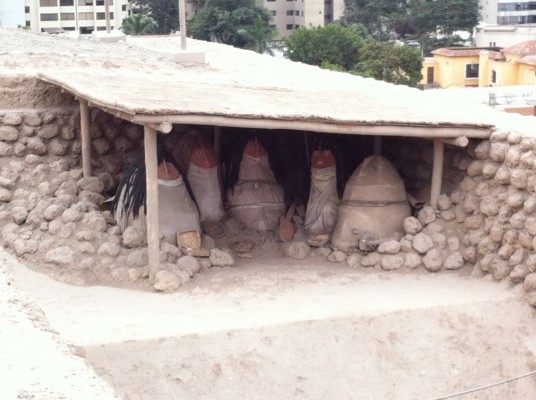
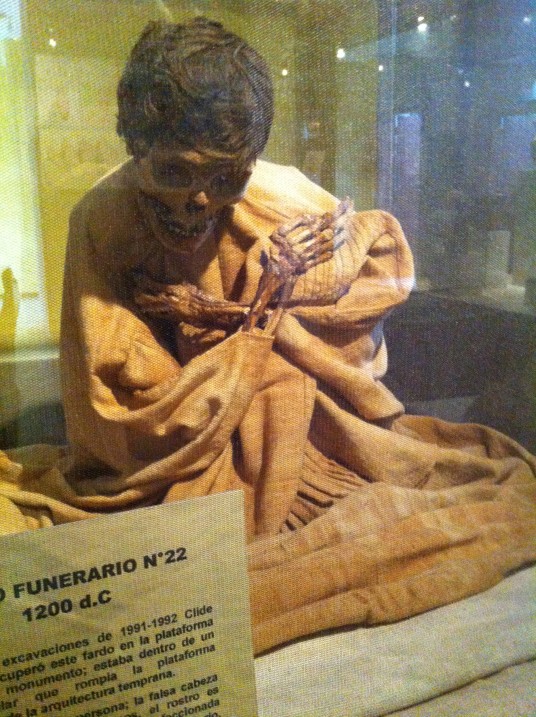
On Sunday Beth ran her half marathon in 1 hour 47 minutes. It was specially hard for her due to the high temperature, humidity, and steady climb towards the finish.
The atmosphere was great. They had two RC quadcopters filming the start and a big blimp with another Movistar ad on it. Oh! and the race was also sponsored by guess.. Movistar!
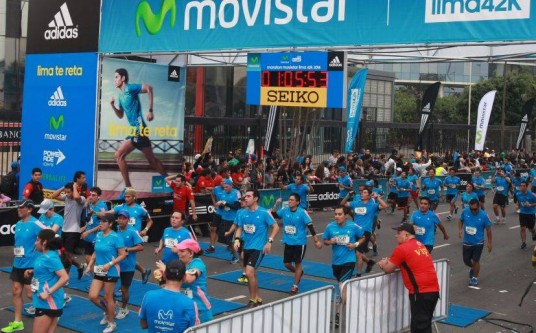
For dinner we asked our taxi driver to take us to Miraflores to a restaurant area.
He took us to an expensive (tourist trap) Peruvian restaurant which just had closed as we got dropped off.
We walked a block down the street and ended up in a Spanish restaurant called “La Eñe“.
Food was great, we had paella. It turned out to be more expensive than we wanted – about $60 USD for both.
On the way back we took a shared bus or “combi”. Most of these buses are very old and extremely cheap. For only 2 soles you can almost go across the entire city.
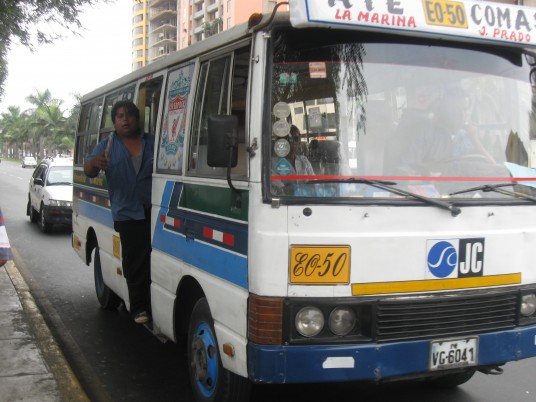
It seems each combi runs as its own business and therefore is in direct competition with other combis.
Standing at the door of each combi there is a person shouting directions and trying to get people in.
They hurry you to get in and to get out as fast as possible.
The drivers seemed to be racing each other which makes riding these little transports quite an experience.
They are continuously cutting each other off and trying to get to the next stop before anyone to snatch as many passengers as possible.
One advantage is that because they are in fierce competition you know you’ll get to your destination as fast as humanly possible. At least in Lima there is no such a thing as waiting for old people, handicapped, or women with strollers. By the way, we never saw a baby stroller, all women carry their babies on their back so they can work and take care of their baby at the same time.
First impressions of Lima: Lots of pollution, unfinished buildings, insane traffic, short smiley people, Scotiabanks everywhere, Movistar ads everywhere, armed police.
In total we spent about 4 days in Lima (2 days upon arrival and 2 days before leaving). It never rained but we never saw the sky either, there seems to be a constant layer of pollution/cloud very similar to what we encountered in Beijing in 2012.
Good Things: arriving to a new country is always exhilarating. I did a bit of research before leaving but not too much as to avoid spoiling the surprise factor.
Public transportation and food are very cheap (if you avoid tourist traps). Many times you see prices in soles equal to those in Canada but soles are 2.5 less valuable than dollars.
Bad things: pollution. Casa Bella owner charges 7% additional if paying with credit card plus an exchange rate of 3 instead of 2.5. As a result we ended up paying about 30% more per night than advertised.
Cusco
Cusco is a smaller city with about half a million inhabitants located at 3,400 meters above sea level.
We liked Cusco a lot better. It feels more authentic but at the same time super touristy. Luckily it’s very easy to have a less touristy experience. Just walk a couple of blocks from Plaza de Armas and you’ll be surrounded by only locals going about their business.
We stayed at Kuska Hostal. It’s located up on the hill with great views of Cusco. The hostal is simple but very well taken care of. The girls in charge are very young and very friendly. In general Peruvians seem very humble, friendly, and smiley.
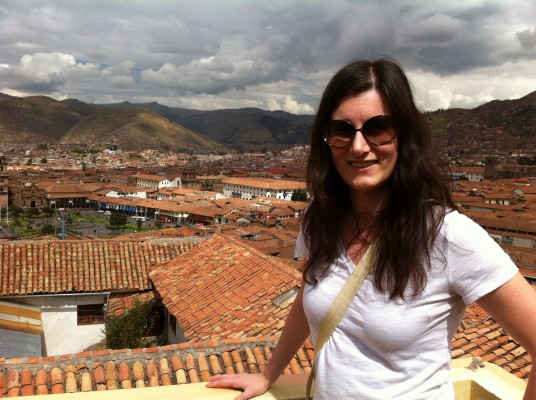
As soon as we arrived they offered us coca tea. Coca tea is very popular to fight altitude sickness.
Luckily neither of us suffered from altitude sickness. Only a bit lightheaded upon exiting the airplane.
When the lack of oxygen is more obvious is going up hills or stairs, as they seem to take twice the effort.
This would be even more obvious later on our trip when hiking at even higher altitudes towards Machu Picchu.
We stayed only for two nights at Cusco to acclimatize to the altitude before starting our 4 day trek to Machu Picchu.
The first day we tried our luck and had lunch at a non-touristy restaurant where only locals go. We had a menu del dia for 4 soles each. The place was a bit scary, the food ok, and luckily we did not get sick.
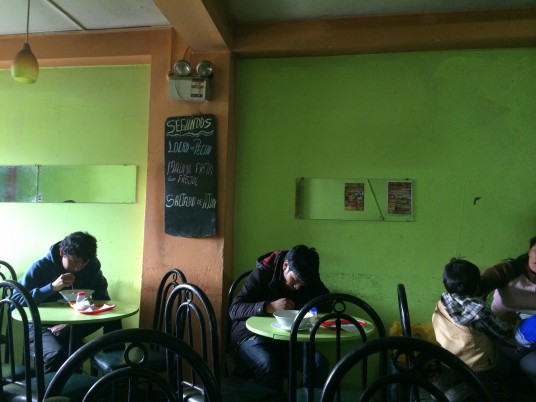
A much better experience was Waynapata Cafe Cultural only about 20 meters down the street from our hostal. A little family owned restaurant and lodge for foreign students that come to learn Spanish.
The place is very small with only about 5 tables. Every night an Italian chef comes over to make delicious pizza using their little brick oven by the entrance.
At this restaurant they had several Peruvian masks. There was something very unique about one of them.. ahem.

During our trip we made an effort to experience both the very touristy and the very local.
On the more touristy side we were surprised to find an amazingly well decorated Starbucks right at Plaza de Armas. The place was designed with a lot of tasteful vintage leather couches and old hardwood floors. There was also the highest Irish Pub on earth.
Because Plaza de Armas is where all the tourists hang out you’ll be approached by dozens of locals trying to sell you tours, baby alpaca garments, and menu del dias with a free pisco sour included.
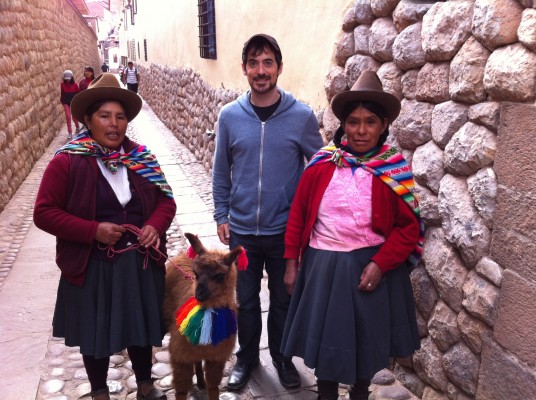
On our train ride from Aguas Clientes to Ollantaytambo we would learn from a local how to tell the difference between real and fake alpaca clothing. The real one feels smoother and clearly cooler in temperature to the touch.
Good things:
Cusco has a more fun, small town vibe. Plaza de Armas is surrounded with unique and very well designed shops and buildings.
Bad things:
More than 90% unfinished buildings. Turns out Peruvians only pay property taxes if the building is completed.
We found about 5 squashed rats on the streets of the local market. Conditions were very unsanitary.
Inca Trail to Machu Picchu
Early Wednesday morning we were picked up by the assistant guide Augusto of Peru-Treks. We got on a bus with our group of 16 people and 22 porters. The bus took about 2 hours to arrive to Ollantaytambo where we had a nice breakfast just before starting our 4 day trek.
The restaurant was conveniently located above a store full of goodies for hikers such as walking poles, rain ponchos, hats, sunscreen lotion, insect repellant, and well everything you’d need for the hike.
And in case you did not find it there you could still buy it from one of the many women vendors that approach you as you exited out of the restaurant.
Our main guide was Manuel (Mani). Like Augusto he was of Quechua origin and spoke Spanish, Quechua, and for us English. He addressed us as “family” and encouraged us to get to know each other since we were about to spend 4 days hiking together.
You can read all about the hike itinerary here: http://www.perutreks.com/inca_trail_04d_itinerary.html
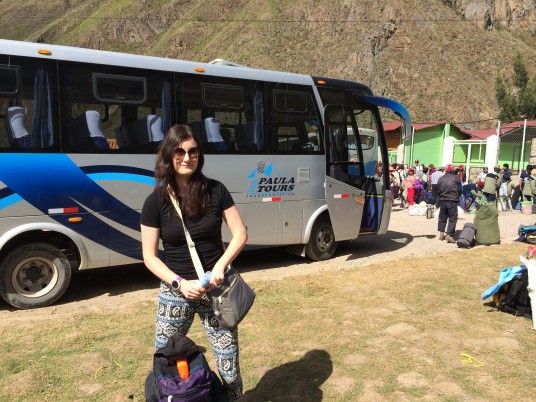
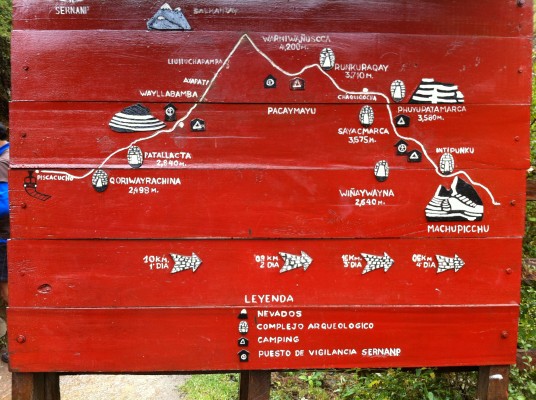
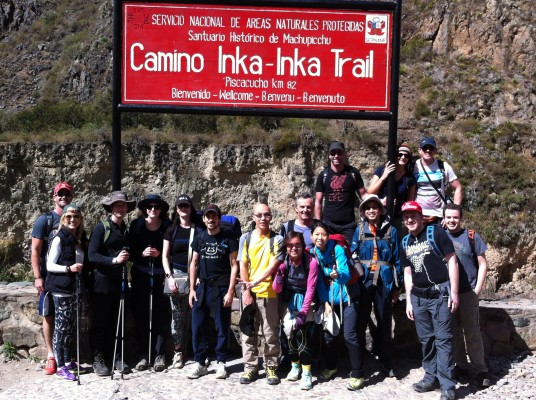
Here are the highlights of each day:
Day 1: Sunny day. We get our passports stamped at the first check point right before the train tracks. Only 500 people including porters allowed per day.
Hike is pretty easy and we stop every hour to either eat, rest, or visit some ruins.
On our lunch stop we get to see some donkeys. The food is fantastic and would continue to be so for the entire hike.
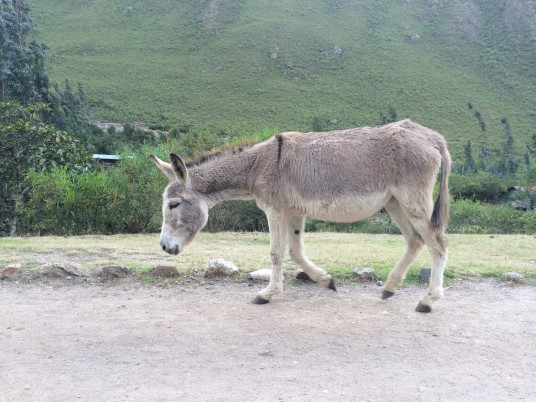
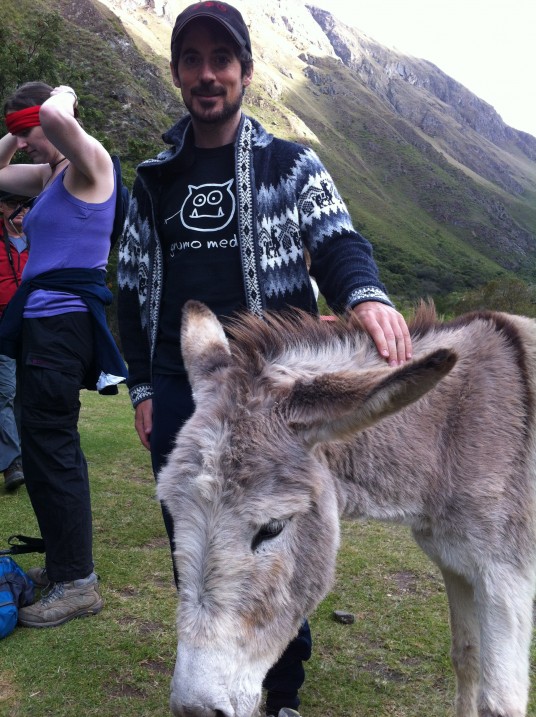
We arrive to the first camp. A group of the younger porters (chasquis in Quechua) play soccer by some ruins.
I watch them play. They are pretty good. They speak a mix of Quechua and Spanish. I can hear them shouting Sergio Ramos, Messi. One of them gets kicked in the face and gets a bloody nose. No big deal, everyone is laughing and having a good time. I want to join but they are even numbers and I feel too shy to interrupt.
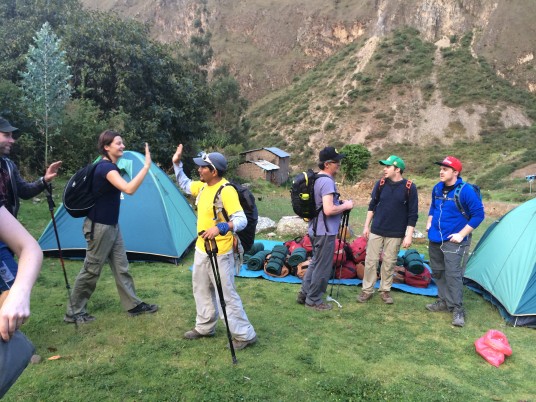
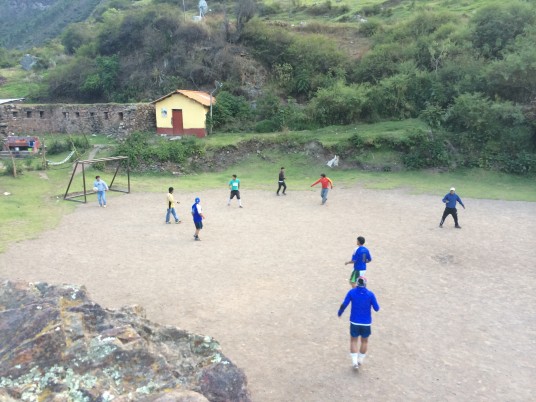
The setting is beautiful. We are surrounded by mountains. There are some ruins with donkeys and stray dogs.
All animals on our trip seem very peaceful, relaxed and friendly like the very Peruvian people.

It gets dark soon at around 5:45pm. We can see millions of stars. The sky is so clear at this altitude it is just mind blowing how many stars are visible. Extremely beautiful.
As the night unfolds we are getting to know our co-hikers better.
Mostly couples, except one guy from Ireland and a 59 year old father from Portland and his two adult kids.
The other couples are from England, South Africa, Ireland/Scotland and two couples from Hong Kong.
For the first time we make use of our LED head lamps. They are super useful.
The British couple brought a wind up flashlight and unfortunately the battery doesn’t last more than 30 seconds.
They regret not having invested in a headlamp. They were trying to be more eco-friendly.
Tents are ready. Everyone else in our group paid the $50 extra to have porters carry 6 kg of their belongings. We are the only ones carrying big backpacks with our sleeping bags and mats. Even with the extra weight our backpacks don’t feel too heavy,
especially in comparison to the packs the porters carry which can weigh up to 35 kg each!
On the first day, at every stop and camp sight there are roaming locals selling water, drinks and ponchos. At this camp there is also one selling beer and the Irish friends happily buy one or two bottles. The local beer is called Cusqueña.
Every night we go to sleep early as we wake up very early too.
Two things we notice right away:
1. Sleeping on your side hurts your hip as the mats provided are very thin and mostly for insulation purposes only.
2. There is only one latrine. It stinks horribly. You need to flush it using a bucket of water.
Most people avoid going number two this day. I go in the morning because old routines die hard 🙂
For the rest of the trip all latrines are disgusting squat type holes. Some flush which is a relief except that the flushing system is not calibrated and in some places it’s so strong it overflows and splashes the whole floor with a mix of water and shit 🙁
Day 2: According to Peru-Treks the 3rd day is supposed to be the hardest. In our case not only was Day 2 was the hardest, it was also one of the most miserable days of our lives.
Around 3:30am before the start of Day 2 it started raining. Then pouring, and then monsooning.
This was supposed to be the dry season but for the next day and a half it would rain non-stop.
Day 2 we hike to the highest point of the trek via Dead Woman’s pass at 4,200 meters of altitude.
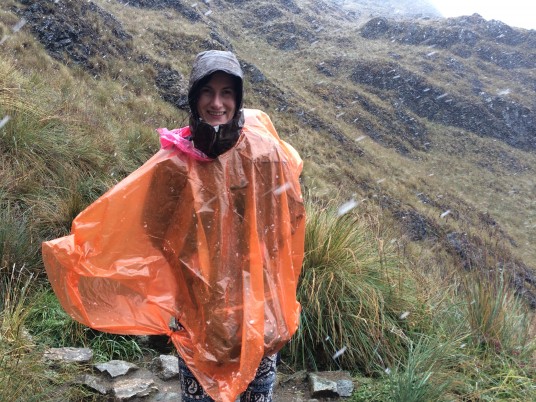
The higher we go the harder it gets to climb the steep and uneven rock stairs. Less oxygen, colder, rain becomes sleet, more wind. Typically trekkers take group pictures at Dead Woman’s pass.
It’s supposed to be the highlight of the day but for us is there is no highlight.
We don’t stop at all and we continue going down the steps on the other side of the pass.
At this stage we are completely soaked to the bone. Our backpacks are soaked too and feel almost twice as heavy.
Beth and I cannot believe we signed up and paid to endure this nightmare.
We move at snail pace, gasping for oxygen, freezing. The ponchos keep our sweat from evaporating so the steam condensates on the inside making all our clothes completely wet.
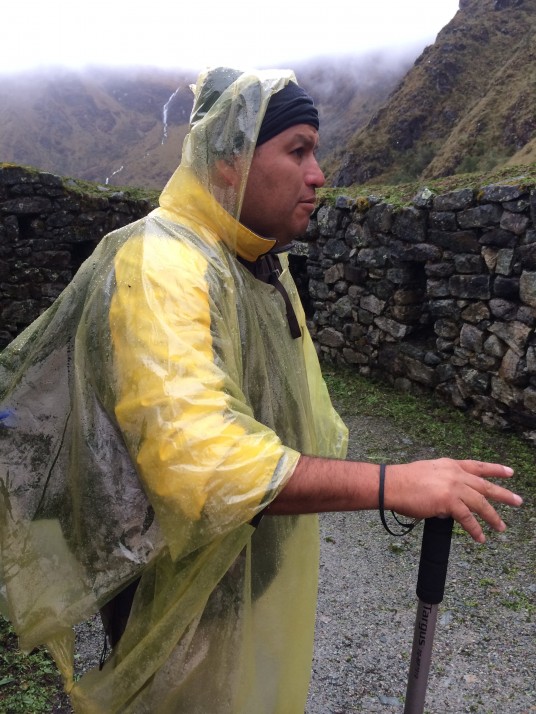
At halfway we stop for lunch. It also stops raining briefly. We are greeted by our porters with some warm chicha morada. Problem is as soon as we stop walking we start shivering because we stop producing heat.
Lunch is good but people spirits are a bit low. It starts raining again and we continue towards our camp.

We arrive to the camp around 2pm. We have a small second lunch. The dinner tent is almost blown away twice due to the strong winds. It keeps pouring.
Most people skip dinner and stay in their tents. Beth is freezing so much I’m afraid she is going to get hypothermia. The best moment comes before going to sleep. Augusto and one porter come to each tent with a mix of hot rum and sugar (he offered it at lunch for 5 soles a cup). Our South African neighbours refuse it even though they already paid for it probably because they don’t want to let any little heat they made escape from their tent.
We drink the hot rum mix. Wow! it feels so good. It immediately triggers an amazing sense of comfort, warmness, and relaxation. We try to sleep. It’s hard because it is cold and our sleeping bags feel wet.
Day 3:
This day is supposed to be hardest crossing two smaller passes and then the steep downhill towards our last day’s camp.
It felt a lot easier than the second day except for our oldest compadre, Mike from Portland which 59 year old knees struggled on the way down.
The highlight of the day was reaching Puyupatamarca camp. By that time it just stopped raining and the views from there were just spectacular.
https://www.youtube.com/watch?v=1CriSsmy6oU&rel=0

The steep downhill starts right after this camp. The rest of the trek felt like a piece of cake compared to Day 2. Now that we could actually see the landscapes everything seemed more enjoyable. The Inca trail takes you through several ruins, some man made tunnels, and lots of varied trees, plants, and flowers.
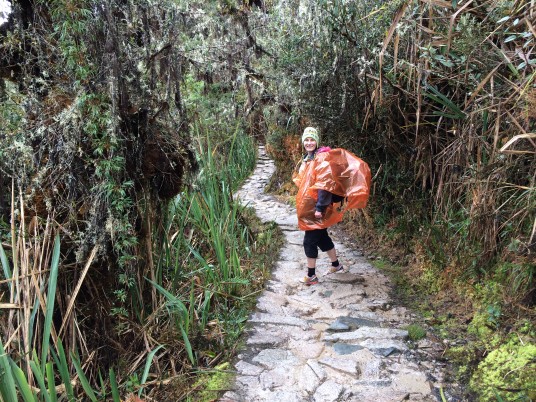
Finally it felt we were getting our money’s worth. This day was by far the most enjoyable hike I’ve experienced in my life. This was a huge contrast with the previous day which was the worst day of my life.
Lows and highs just like the Inca trail itself, peaks and valleys. Life feels more interesting this way.
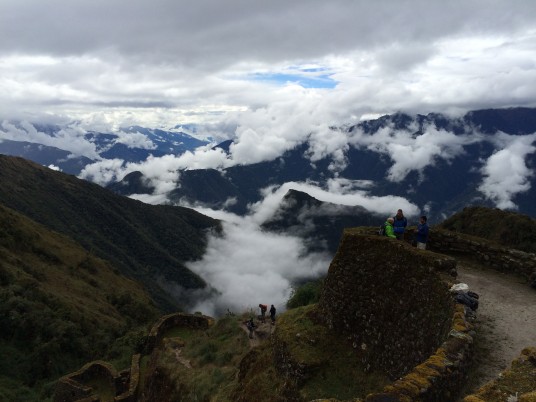
Eventually, after meeting our first alpacas (or llamas, no one seemed to know the difference) up close we hike down to our last camp just about 2 hours hiking from our final destination, Machu Picchu.
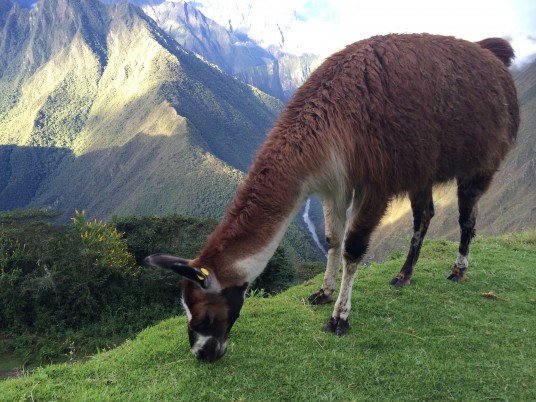
Our amazing porters welcome each hiker with a round of applause. This is all part of a common scheme orchestrated by all tour companies in preparation for the awkward tipping ceremony that comes after dinner.
Luckily the tour organizers had explained everything about tipping on a long document before starting our trek. The explanation is all very confusing and it took 16 reasonably intelligent trekkers about 30 minutes to figure out how much to tip the porters.
Eventually we settled on 50 soles for the porters and 10 soles for the chef per person.
There is no way to tell if that is too much, too little, or what they expected and of course no one will tell you. Our tour organizers told us everyone gets paid fair wages and even above other operators.
I don’t think anyone is against tipping. The food was outstanding and better than in many restaurants. How do they manage to cook such exquisite 3 course meals without a proper kitchen is beyond understanding.
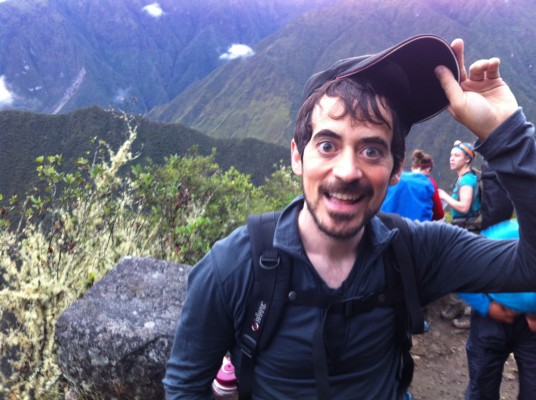
At lunch they introduced all 21 porters one by one. (Note that there were 21 porters, 1 cook, 2 guides, and 16 hikers. There were more porters than hikers. Some tour operators have a lower ratio which means porters have to carry even more weight probably breaking the established maximum cargo regulations).
All porters said their name, age, number of kids, and years working as a porter.
Average age was about 30. There were only 2 single porters with no kids including the youngest at 18 years old and only one month working as a porter.
Although not explained it was obvious that the whole purpose of introducing us to the porters at this stage was to build rapport with them with the ulterior motive of increasing the tips at the end of the day.
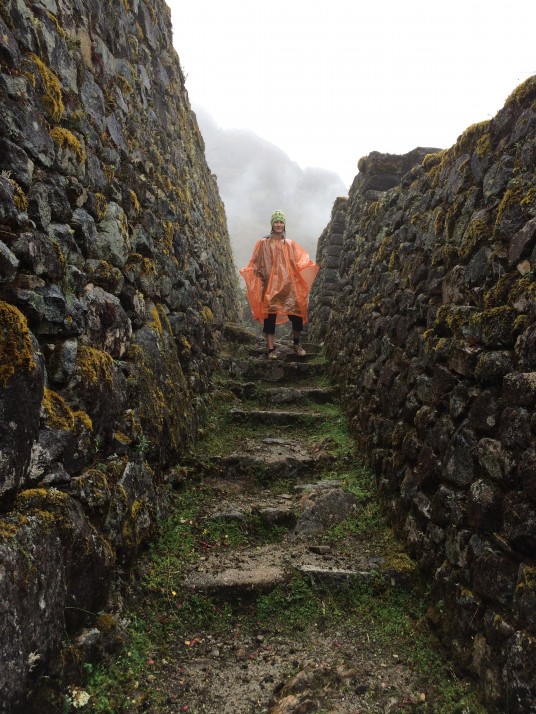
Awkward speech:
I must say the most awkward part of the whole tipping ceremony was when I was asked to give a thank you speech in Spanish (luckily my native language) to all the porters and chef gathered inside the dinner tent.
My speech has to be divided into thanking the chef first and then all the porters.
I had no time to prepare and it all felt very awkward. I don’t mind repeating the word awkward because I rarely use it and everything about this experience felt perfectly awkward.
I have no experience in public speaking and this is the last place I’d imagine I would be doing my debut.
The only time I did something similar was when I was 14 (well over two decades ago) when I was getting sworn into a new level in the boy scouts back in Spain.
At that time I had plenty of time to come up with a speech. Most kids kept it short and generic.
My speech was epic. Everyone was completely confused and amazed at the same time.
One of the things I remember from it was the beginning. It started like this: “I promise to keep this promise for as long as I remember to keep it. Because you know, we all forget things in time so I cannot speak of my acts past the time I forget. With this in mind here is my pledge.. blah blah blah..”.
In contrast, now I had no time and I was in the middle of the Andes with 22 Quechuans as my audience. I mumbled some incoherent words in Spanish which were less incoherent than the couple words mumbled by two fellow hikers who claimed to speak a bit of Spanish.
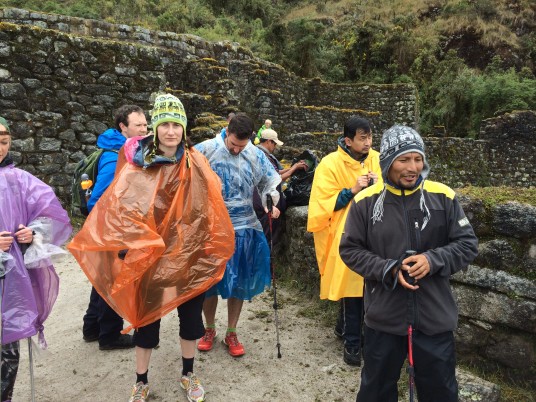
For a moment I realized what being a politician or CEO of a big company must feel like.
Turns out that when you are asked to speak on behalf of a group you have to omit your own personal opinions.
You become a proxy for a group of minds. It is a very weird sensation, I felt trapped.. yes and awkwardly so.
You see, If I was speaking on my behalf I could say whatever I felt like, be more natural, be myself.
But how can you be yourself when you are supposed to be a combination of everyone around you?
This becomes exponentially harder when: 1. You have little or no experience public speaking. 2. You don’t really know what the people you represent actually think. 3. You are given no time to prepare. 4. The whole situation feels forced and unnatural.
Under other circumstances, say I was 10 years younger, I would’ve felt very embarrassed and upset.
In this case I just felt a bit annoyed at the whole situation and even a bit amused at the thought that my first speech in 20 years had occurred under such unique circumstances.
I spent the rest of the night thinking about better ways to handle this tipping conundrum which apparently thousands of hikers have been subjected to over the years.
As much as I tried to come up with a less awkward solution I couldn’t because the very act of tipping is inherently awkward in itself. The only way to remove the awkwardness would be to remove tipping all together. Tipping is about showing gratitude with money. Problem is that is the same as trying to put a price to how much you love your pet or spouse. Emotions cannot be measured with dollars or pounds so the problem cannot be solved with a simple equation.
It all comes down to unwritten fluffy rules decided ad hoc by the status quo.
In Canada, it is customary to tip 15% for meals. In most countries the amount varies but it is usually proportional to the degree of satisfaction with the service provided.
(For an amazing discussion about tipping please read this article.)
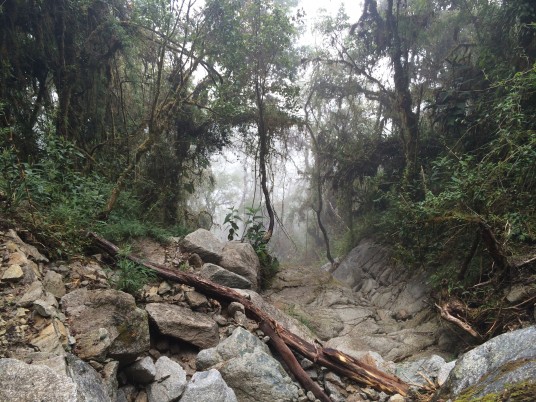
Well, I gave my little speech and in return I got lukewarm applause from everyone who were probably feeling sorry for me.
After the speech we shook hands with each of the porters. If there was a time to feel guilty about how much we tipped then this was a perfect moment.
At one point I thought, what if I was extremely wealthy and I wrote a cheque for a million dollars for each porter? What would be their reaction? how much would that mess up with their lives? Would I feel better with myself?
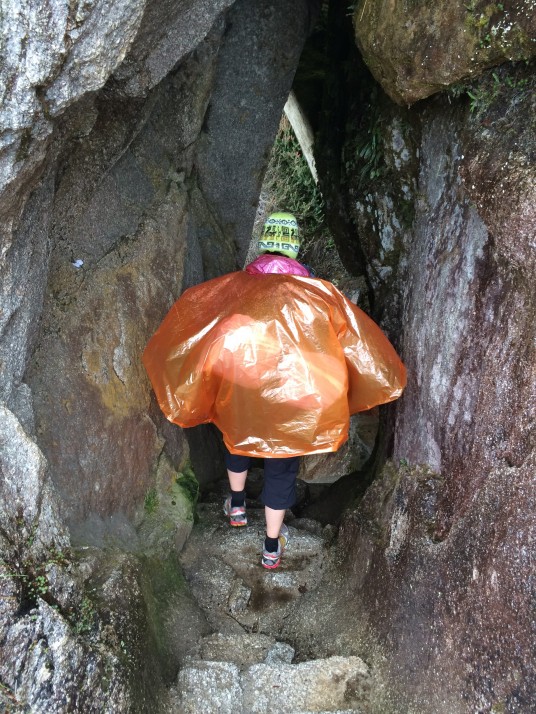
Maybe the solution is to create a savings account for all the money related awkward things in life.
Connect it to an app so every time an awkward money situation is approached the app calculates the optimum tipping amount based on millions of calculated data points and it is delivered immediately to its deserving recipients.
The Porters:
The porters are super humans. They come from small villages and speak little or no English.
On average they are very short (under 5’4″) but extremely muscular with calves of steel.

Each day the porters leave after us and arrive before us to set up the tents and prepare food.
To do so they walk and even run up and down the trail making us foreigners look like complaining little white pussy tortoises. Their personal weight to cargo weight ratio is insane. They carry more than half their body weight in cargo. When I felt tired and miserable one day my motivation was thinking how easy and cozy my life was in comparison so these smiley little super human porters.

Day 4:
We wake up very early at around 3:40am. Only 2 hours to our final destination.
We check out at our last check point and head into the dark with our head lamps towards the Sun Gate.
The hike feels like a piece of cake for Beth and I because we have returned our sleeping bags and mats to the porters since we won’t need them anymore.
We arrived to the Sun Gate not before climbing about 50 super steep stairs. Once up there hundreds of hikers gather to see the sun come over the mountains and illuminate Machu Picchu. This all feels super touristy but still a great sense of accomplishment is unavoidable.
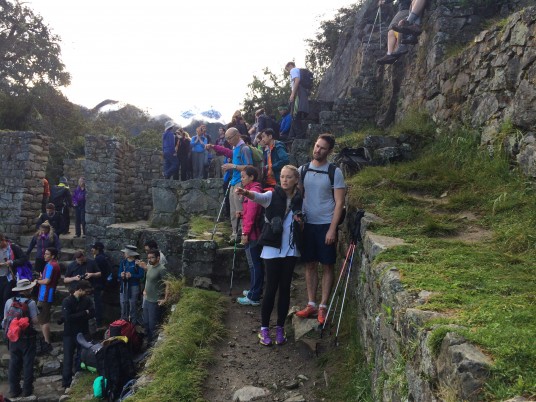
After the sun comes up we hike about 25 mins to reach the ruins. As beautiful as the ruins are the beauty of the hike is the hike itself, or how a fellow hiker put it and we’ve heard zillions of times before – It’s not about the destination but about the journey.
Well, the destination in this case deserves much recognition as well. Machu Picchu would take days to see and learn in detail. However by this time everyone in the group is super tired, now it’s finally hot, and we are surrounded by thousands of tourists from all around the world who took the shortcut train from Cusco instead of hiking like us.
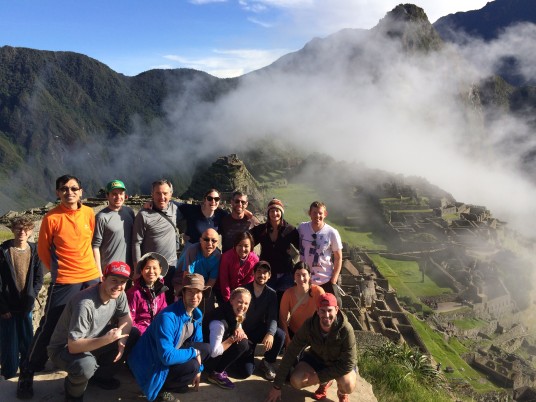
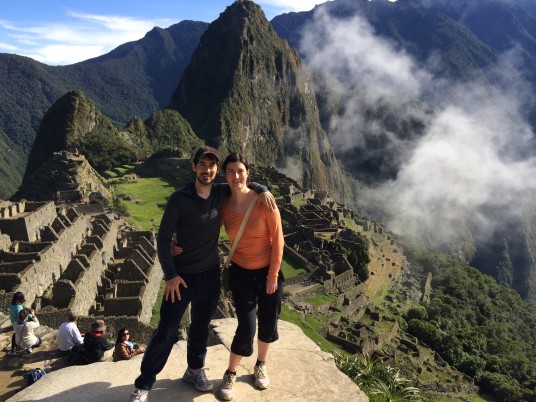
After 2 hours of Machu Picchu guided tour by Mani we are left to explore on our own but Beth and I take the next bus down to Aguas Calientes where our next hotel awaits.
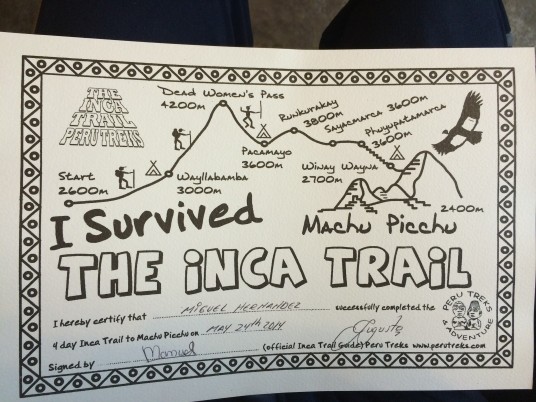
We arrived to Aguas Calientes which in fact is called Machu Picchu town. The next day we visited the hot springs which are the reason for the former name but they turned out to be not so hot and not so clean.
They felt more like lukewarm fecal waters. The brown was explained as being “medicinal” so as long as you did not drink it you would survive.
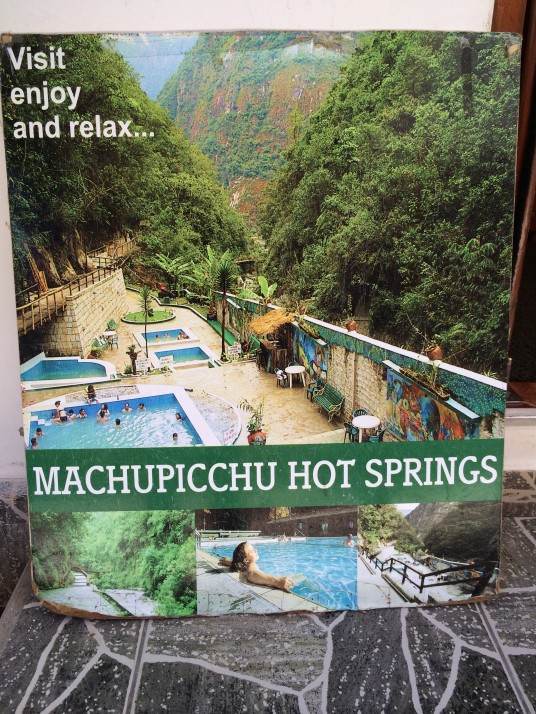
Aguas Calientes is even more touristy than Cusco. In fact, the whole town is just for tourists going to and from Machu Picchu. There are hundreds if not thousands of restaurants. I dare to say if you took out all the tourists there is probably one restaurant per inhabitant.
At 2pm on Day 4 we met for a final lunch with our group at Ayllu restaurant. This meeting had a bitter-sweet feeling for me due to a combination of factors. 1. It was the last time we would see everyone in our group. 2. The UEFA final with Real Madrid vs Atletico de Madrid was playing at the same time so all the boys where paying attention to the screen instead of socializing during our last moments together. 3. More awkward tipping situations.
So now it is time to tip the guides. First the assistant guide who is supposed to get less than the first guide.
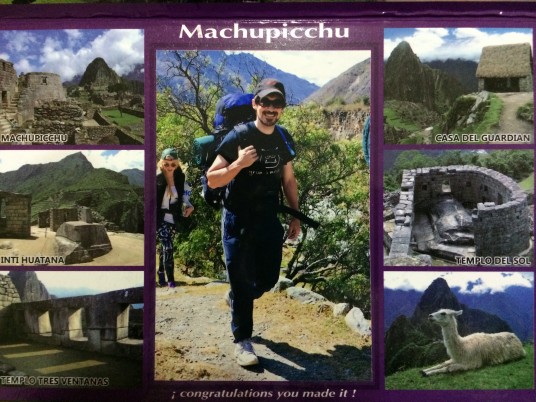
We gave 70 soles to the assistant and 100 to the first guide. It all felt super awkward because both seem to linger after lunch and no one knew when it was time to tip.
Even though Beth and I gave more than suggested I still sensed a bit of disappointment on Mani’s face.
I asked him if everything was OK, but this is a futile effort similar to asking a 17 year old girlfriend why she is mad at you. Answer: you should know it and if you don’t you are an asshole.
Although Atletico did not win, the game was epic thanks to the equalizing goal by Sergio Ramos in the last minute of injury time. The 4-1 was scored by Ronaldo who took his shirt off consolidating himself as the biggest egomaniac of this century in sports.
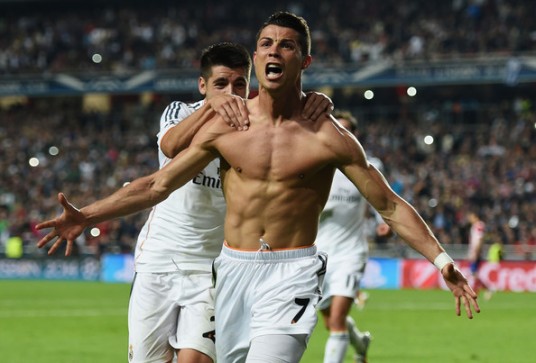
Aguas Calientes:
The next day was a relaxation day. We stayed at the Wiracocha Inn which is on the hill on the way to the hot springs.
Taking our first shower after 4 days hiking and sleeping on a real mattress felt wonderful.
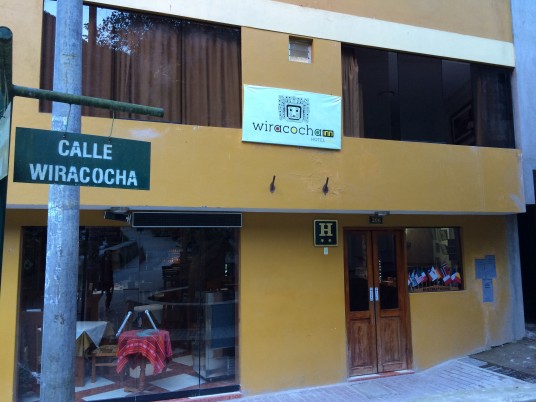
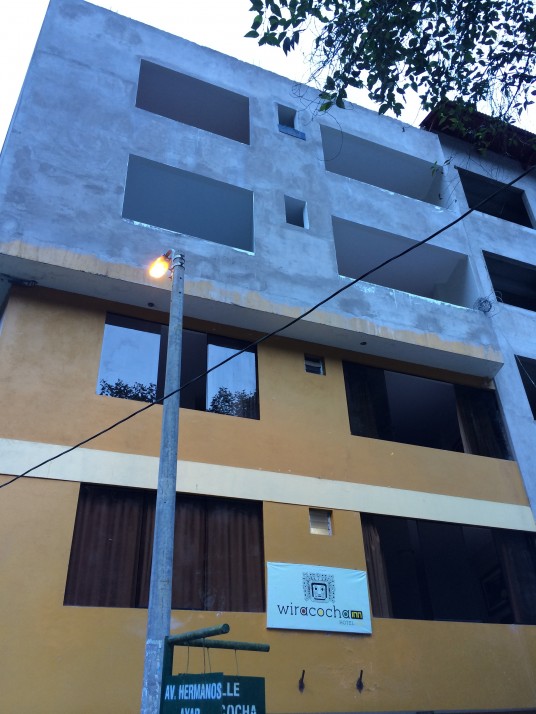
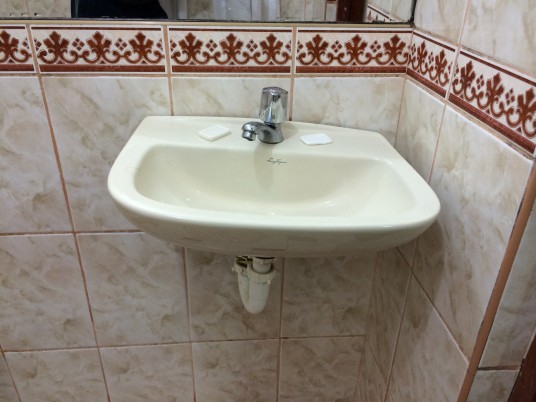
We went to a small nail salon and had my first pedicure done. I felt very girly doing it but got to understand why women love these places. It feels very nice having someone massaging and paying attention to your feet specially after hiking for so long.
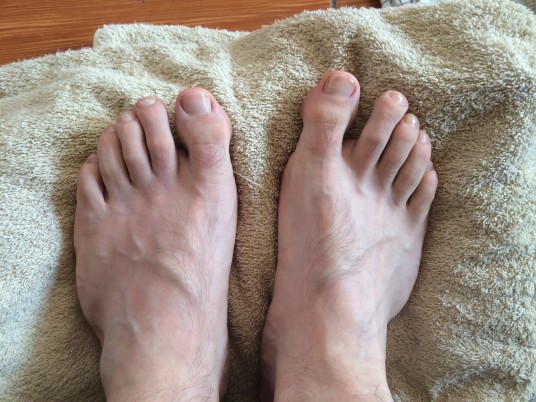
This day we walked all over Aguas Calientes several times to kill time before taking the 6:45pm train to Cusco. We saw many street dogs. They all seemed happy, well fed, and relaxed.
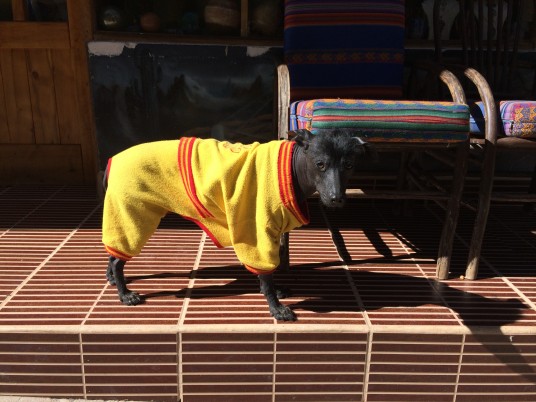
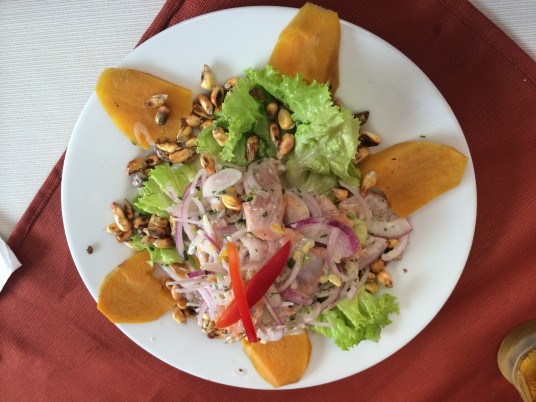
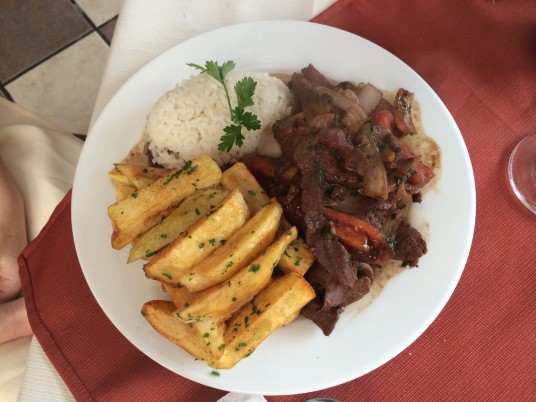
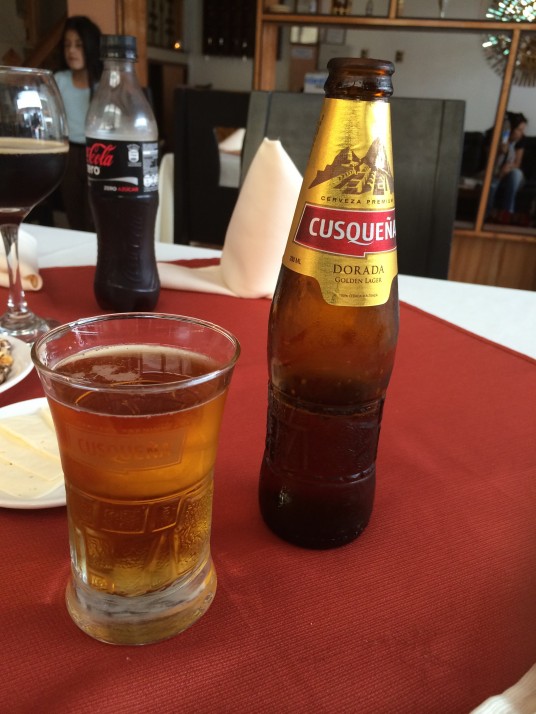
We asked a local why most buildings were unfinished here too. He said that people build stories as they can afford and everyone wants to build up to the 4 or 5 stories allowed. Not sure why he would make up a lie but my research online yielded a different and more probable explanation. Peruvians don’t pay property taxes unless their building/house is completed so they never complete their houses on purpose!
The train to Cusco runs right through the heart of Aguas Calientes. There are no fences or safety devices between pedestrians and the train tracks. Houses are literally inches from the train when it passes.

It’s very amusing to see a train go by every few minutes, very loud diesel locomotives roaring slowly among a town full of tourists, locals, and street dogs.
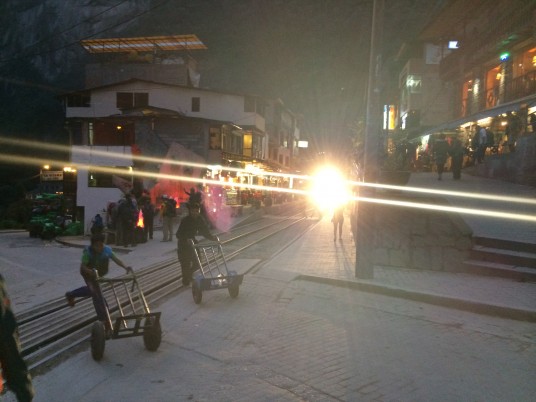
Back to Cusco
On the train from Aguas Calientes to Ollantaytambo every body seemed to have been assigned random seats.
Either on purpose or by computer error. Beth and I were seated on aisle seats on the same row.
This meant that we were seating by strangers which turned out to be great travel companions.
On my right there was a pretty 19 year old blonde from Indiana. It was the first time she travelled and her friend was sitting in another wagon. She did a more difficult hike towards Machu Picchu. Considering her age and little experience travelling we were pretty amazed to hear she had climbed near glaciers, eating way less food, and dealing with even higher altitudes.
The girl sitting beside Beth was Peruvian and also in her early twenties. She was an avid Real Madrid fan and was very happy that they won the UEFA Champions and that Ronaldo had taken his shirt off after his goal.
Her name was Natalie and she recommended a few places to visit in Lima. She also is the one that told us how to tell the difference between real and fake alpaca clothing (real alpaca feels smoother and colder).
Because the train only goes to Ollantaytambo then we had to find a bus to Cusco. It was quite easy to find one and after another 2 hours of bus ride we arrived to Cusco back to our original Kuska Hostal and even the same room 303.
Before going on our hike we had left a suitcase and my backpack with my laptop and iPad because we only needed the essentials for our hike. We were very relieved to find out the girls at Kuska Hostal had taken care of all our belongings.
Luxury Train to Puno
We did not have much time to relax. We arrived after midnight to Cusco and we were leaving at 8 am on the Andean train to Puno.
Our hostess arranged a taxi at 6:30am which showed up right on time which took only 15 minutes to take us to the station.
At the train station lobby all passengers gathered while a trio of typical Peruvian musicians kept us entertained. As I expected most people taking this trip were older. The typical backpacker on a budget doesn’t take a $260 train ride. But once on the train we saw a few groups of younger people.
The 10 hour train ride went faster than expected. The food was amazing, there was entertainment, and we stopped once and made friends with a couple from Brazil.

We thought we would have separate seats facing the direction of travel but it turned out we were seated against the direction of travel at a table for four facing another couple.
Beth was not very happy about this as she didn’t want to travel facing backwards for 10 hours and asked to be placed somewhere else. While we waited we started talking to the Brazilian couple. They were so nice we kind of felt bad leaving when they reassigned us to seats by ourselves about 4 wagons ahead.
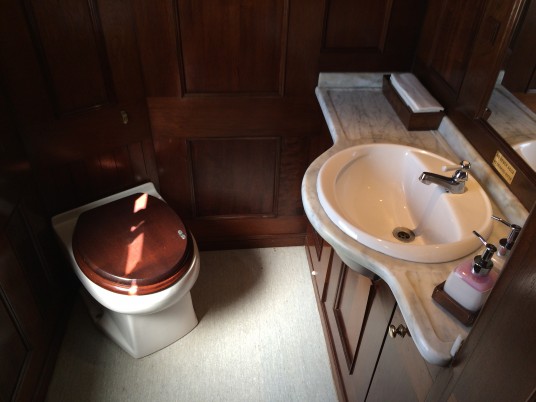
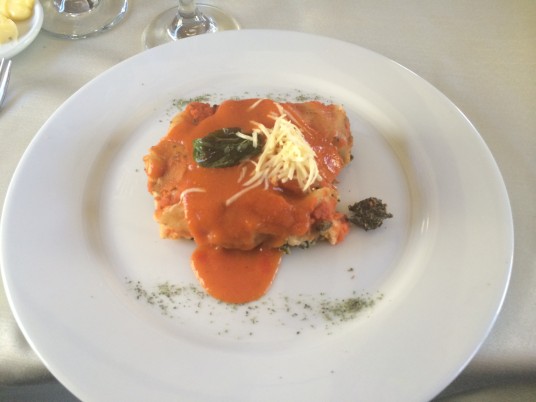
It turned out to be fine because the ride is so long we had plenty of time to meet them back at the observatory wagon at the end of the train. We invited each other to a round of cervezas and pisco sours and got to know more about their travels and life in San Paulo.
Their names where Kanaãm and Marcela. Turns out Kanaãm had just proposed to Marcela at the top of Wayna Picchu.
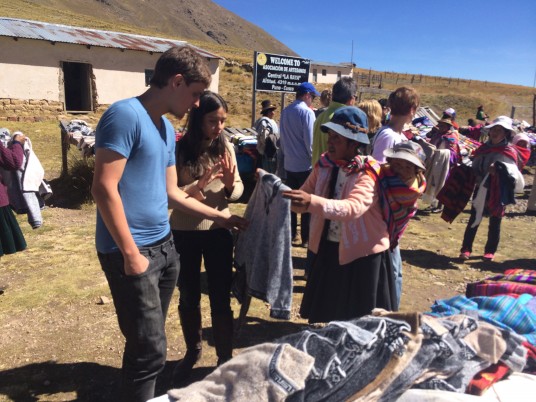
What is more amazing is that it was the first time they had a conversation in English and their English was amazingly good. Kanaãm was self taught and Marcela had taken lessons but her accent was better then mine (and I’ve been 18 years living in Canada).
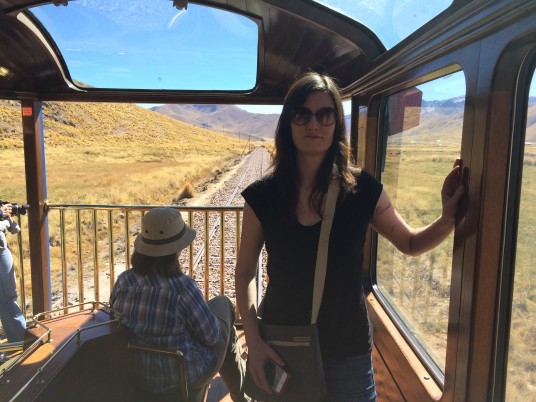
Floating Islands and Taquile – Titicaca Lake
In total we stayed two days in Puno. The first day we joined the Brazilian couple to visit the floating islands and Taquile island at Titicaca Lake.
The tour took most of the day and cost only 45 soles each including a nice lunch in Taquile with amazing views of Titicaca.
Our guide was Angel and had 32 years of experience as a guide. Angel was very thorough and spoke clearly. In general all our guides had been super professional, friendly and very helpful.
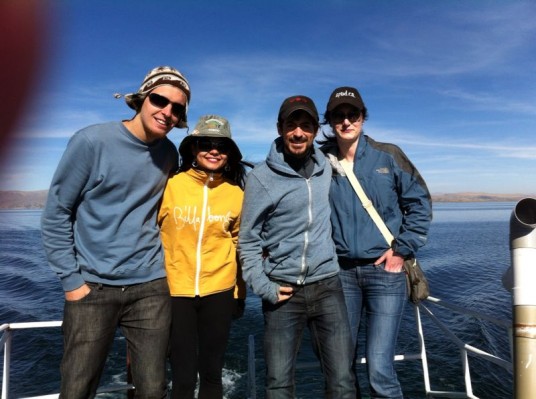
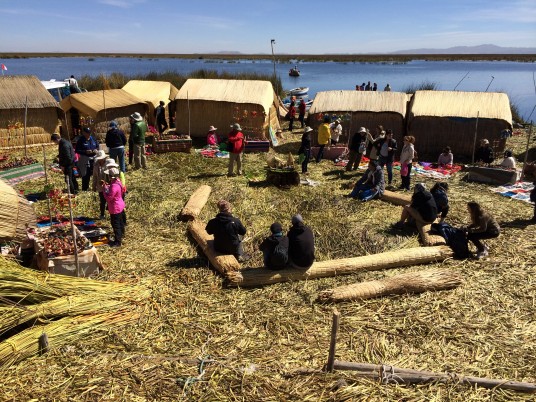
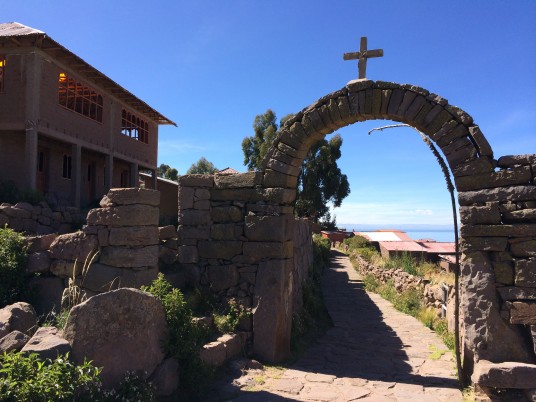
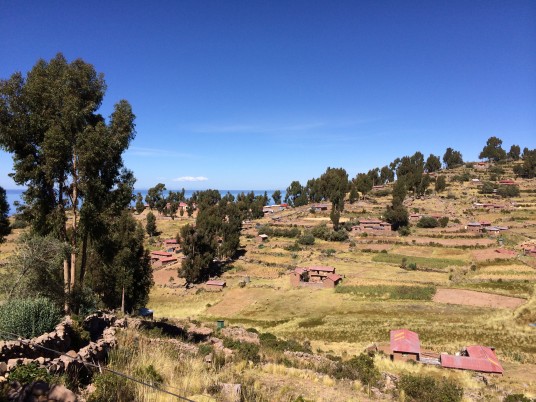
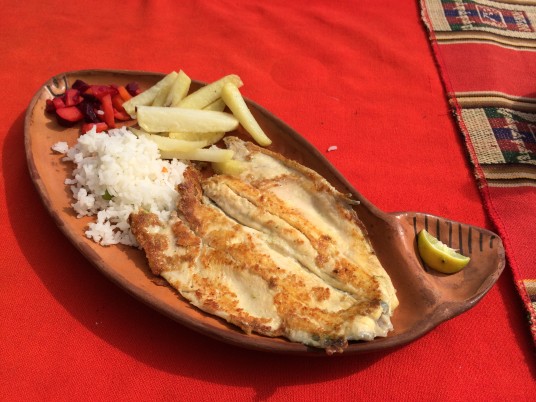
The next day Beth wanted to sleep in and relax so we did not plan any tours for the day.
We just walked around Puno and had a fantastic lunch at La Casona for 20 soles each.

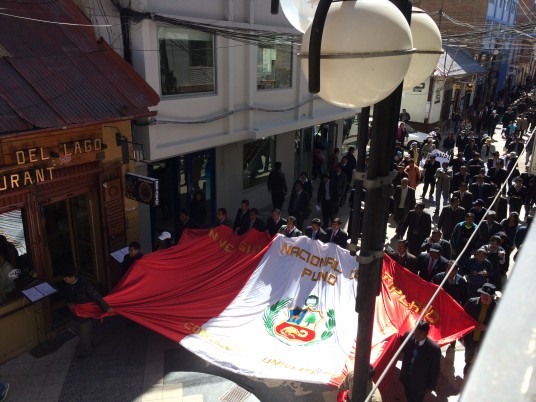
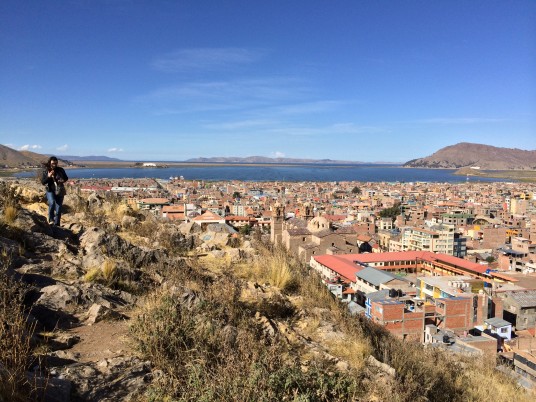
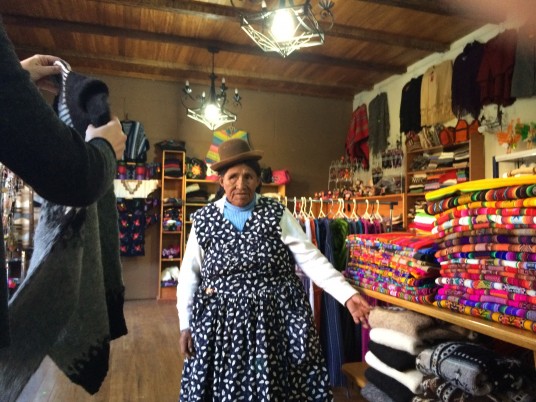
Our Brazilian friends spent the afternoon visiting the Sillustani pre-incas burial grounds which is the other main attraction in Puno.
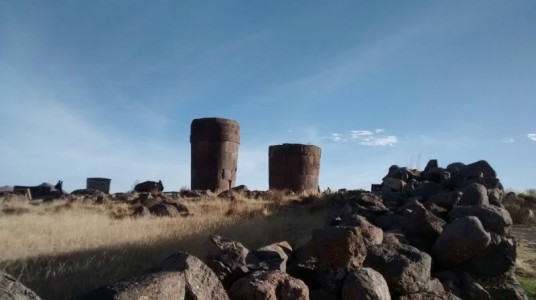
That night we had our last dinner with the Brazilian couple. They were on a budget so they picked one of the few places that had dinner for only 15 soles. The place was empty and Beth was suspicious. The food was pretty bad and the gamble eventually got her. The rest of the trip she had pretty serious stomach problems 🙁

Back to Lima
Next morning we took a shared bus to the Juliaca airport about 1 hour from Puno for 15 soles each.
The last part of the road just arriving to the airport was blocked due to construction and all the buses and taxis were re-routed along an insanely bumpy and dusty road.
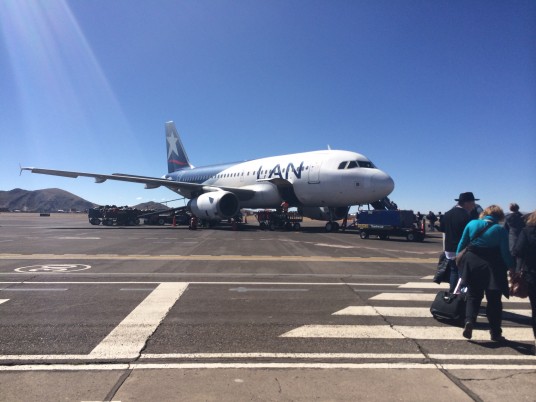
We made it with plenty of time. I finally bought a typical Peruvian hat at the Juliaca airport. Everyday, except during the hike, we stopped at countless shops with thousands of hat variations. I experienced extreme decision paralysis so eventually just picked up the first hat that I thought was not too boring and not too girly.
The last 2 days in Lima were quite uneventful. Partly because Beth was quite sick and partly because by now we were exhausted from travelling. We stayed at a very nice hotel in the middle of Miraflores called Casa Andina Select. Beth had managed to get a really good deal of $230 for 3 nights except that by mistake she booked an extra night. Even with the mistake we ended up paying less than if she had booked two nights at their regular rate.
We guessed she got such a good rate because the building next door was under construction and they were repairing the facade of the hotel. Luckily we barely experienced any noise or inconvenience.
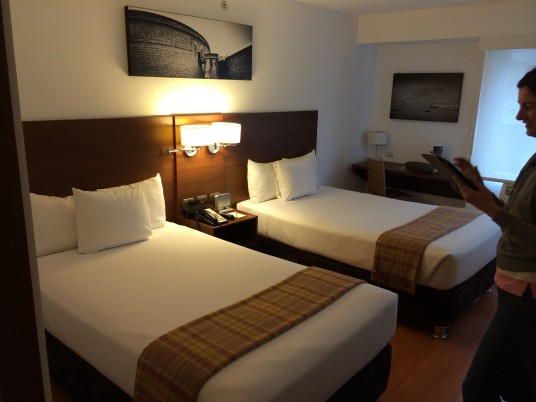
Miraflores feels a lot more cosmopolitan than San Isidro. You can tell this is the preferred destination for most travellers. It is closer to the sea and to all the main shops.
The first night I’m ashamed to admit that upon request from Beth we ended up eating from Subway. For some reason it feels like cheating when you eat at a common fast food chain in a foreign country.
Peruvians have their own version of McDonalds and it is called Bembos. We tried Bembos in San Isidro when we arrived to Lima the beginning of our trip.
The last day in Lima we walked down Larco Avenue towards the Larcomar mall by the sea side.

On our way back we stopped at Kenedy Park which Beth loved because it was full of homeless cats mingling with people. For some reason this park is like a sanctuary for cats.
People feed them and take care of them but they don’t belong to anyone. The cats are so accustomed to visitors it is not unusual to see them cuddling on top of people sitting on the benches.

For dinner we went to a restaurant called Cafe de la Paz where we had some pretty good La Paz sandwiches.
That same night, now Friday 30th, at 10 pm we had arranged a private transport from Peruvian Shuttle for $22 USD to take us to the airport to take our 7 hour flight to Dallas and from there to Vancouver.
American Airlines BS
I have not confirmed this yet but it seems that American Airlines takes extra precautions when boarding inbound planes from certain countries like Peru. It looks as if they don’t trust Peruvian security measures so they perform their own set of inspections before boarding.
Typically, once you pass security at an airport you are not required to repeat the process at the gate before boarding your plane and you are allowed to take on board food and drinks purchased at the gate.
This was not the case when boarding our plane from Lima to Dallas (AA 988). Everyone entering the plane had their belongings manually inspected and asked to get rid of any drinks purchased while waiting.
Considering a litre of water cost Beth $5 USD at the gate (10 times more than the 2.5 litres bottle we had purchased the day before at a local market for $1 USD) this was very upsetting.
Beth complained to the security staff. They just shrugged and didn’t say a word, just stuck to their script.
If anyone from AA reads this. Please, have a sign at the gate clearly indicating that drinks are not allowed on board.
AA from Dallas to Vancouver was fine. The plane was brand new with a very nifty entertainment screen on the back of all seats. Unfortunately one of my flying nightmares came true. I was stuck at the end of the plane. Beth got the window seat because she didn’t want to sit beside a stranger in case they were super obese and smelly. Guess what, I was stuck beside a huge old 350 pound man. Luckily he was not smelly 🙂
When will day airlines will fix this obvious injustice? why someone that weights twice as you, takes 20% of your seat pays the same?. I know there are many delicate feelings at stake but it just doesn’t seem fair that we have to pay for other’s bad eating habits. UPS and FedEx charge by volume and weight but when it comes to human flesh logic goes out the window.
Anyway, even though to top this off we had two teenagers punching the back of our seats and a screaming baby behind on the other side I think I faired very well thanks to my super tuning out powers.
After all, these are only little first world problems. All I have to do is think of the super human porters and to remember how lucky I am I can afford a plane ticket to take me home to beautiful Vancouver, Canada.
After Thoughts
It’s amazing how many adventures we experienced during our two weeks in Peru.
Beth organized the whole trip and signed up for the Inca Trail back in December as the waiting list is huge and only 500 hikers are allowed per day including porters.
At first, I was feeling a bit lazy to travel. There is something about taking planes and going through security checks that feels very tiring after some years.
In fact, when I arrived to Lima I did not take any picture for the first two days. I felt like – here we go another crowded city full of cars and pollution. What I’m doing here but being just another tourist intruder.
Slowly but surely I grew fonder and fonder of Peru, its people, food, and amazing landscapes.
After our epic trek to Machu Picchu I even thought of becoming a porter for maybe 6 months and make a documentary of my experience learning about the chasquis.
The porters are so amazing and we got to learn so little about their lives and customs.
I hope you enjoyed some bits of this post. I really recommend you visit Peru and make your own adventures.
Thanks for reading and happy travels!
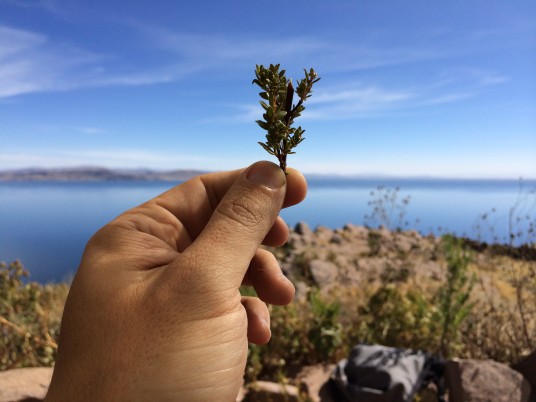
Some trivia from our trip:
- Porters in Quechua is “chasquis”.
- $1 USD about 2.5 soles.
- There were many other pre-inca civilizations. The incas were just the last indigenous tribe before the Spaniards fooked everything.
- Machu Picchu means old peak in Quechua.
- Bunda means ass in Portuguese.
- Amara is the language spoken by the Uros people of the floating islands in Titicaca lake.
- The sign on most Peruvian bathrooms reads SS.HH. and stands for Servicios Higienicos.
- Security officers have written the word “Serenazgo” on their jackets.
- Taxis don’t have meters. You need to agree on a price before getting in.
- You can haggle prices almost everywhere but we felt prices were reasonable and did not haggle a single time.
- Don’t expect no rain in the dry season. Mountain weather is unpredictable.
- Peruvian drivers honk all the time at everything and everyone.
- Taxi drivers honk even more because they also honk at people to get their attention in case they are looking for a ride.
- Peru’s economy has grown tremendously in the last 10 years.
- I’ve never seen so many brand new LED stop and pedestrian lights anywhere. Even in smaller cities like Cusco and Puno.
- There are VW beetles everywhere.
- Titicaca is in Quechua language and is pronounced with a strong “k” sound (“caca” means shit in many languages). Instead the “k” sounds more gutural as coming from the back of the throat, More like “Titigkagka”
- Titicaca means “Rock Puma” (source: Wikipedia)
- Before our trip I unlocked my phone online hoping I could use a local SIM card (using this website). I took too long and it was unlocked just one day before leaving Peru.
- Both in Cusco and Puno there were giant statues of ancient Inca governors.
- Although many buildings are unfinished most look fantastic inside.
- The most dangerous part of the trek are the porters passing by. In many points the trail is very narrow and runs beside super steep and deep cliffs. The only two times I almost fell were when some one shouted “porter!” and I turned around to check which side he was coming from. The act of turning with a heavy back back can throw you off balance and when the stairs are so uneven it is very easy to lose your footing. My recommendation is to never look back. Just keep walking slowly or stay still until the porter walks around you. Your guide will also recommend you always walk closer to the mountain side so you don’t get accidentally pushed off the cliff by one of the porters’ huge backpacks.
- Merino wool t-shirts by Icebreaker are the best invention ever. I wore two at the same time for several days and they kept me warm and never smelled.
Leave a Reply